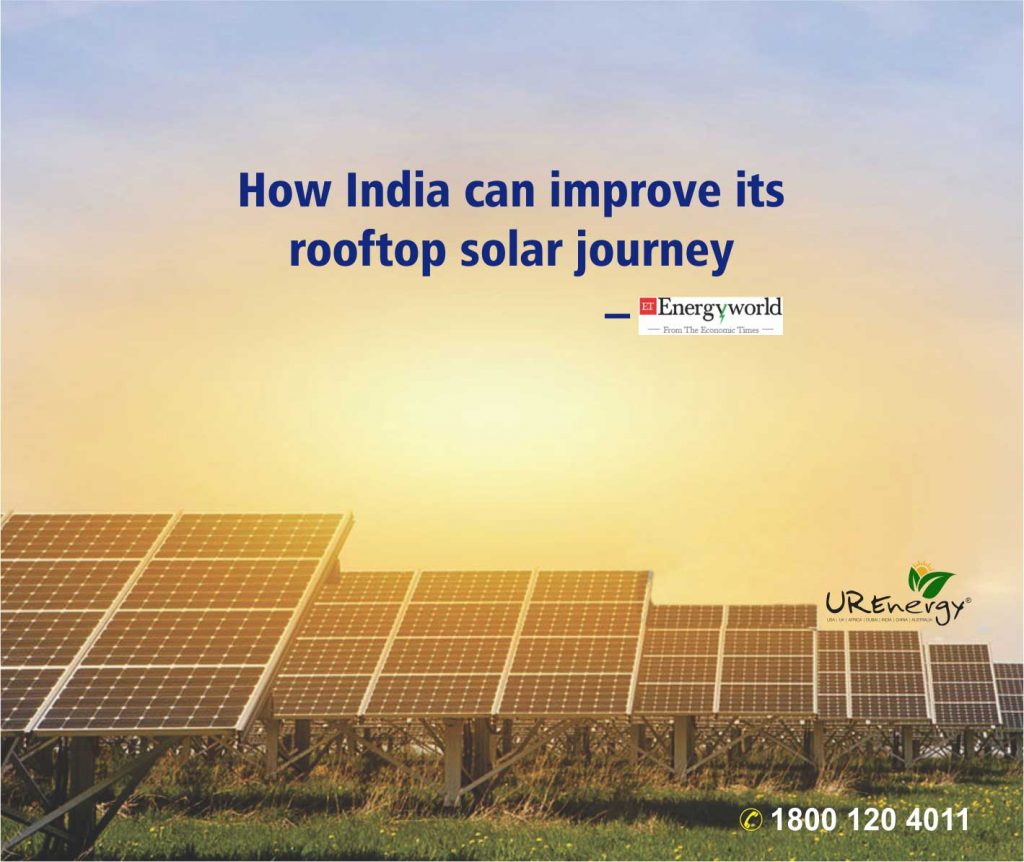With India emerging as the bellwether nation in the global movement towards increased renewable energy adoption, streamlining policy measures with unwavering focus on reliability and sustainability of Solar PV is the way forward for the domestic rooftop segment.

Energy security is perhaps the most powerful lever that pivots the growth trajectory of an economy irrespective of the country’s political milieu. Massive international efforts invested in decarbonization over the past few decades have proven that renewable energy, with its enduring potential is no doubt a far more potent propeller of inclusive development than its conventional counterparts. Ideologically too, this movement toward greener energy is redefining what it means to be a responsible entity, be it individual, corporate or nation.
India has a vociferous renewable energy agenda articulated by Prime Minister Narendra Modi and Power Minister Piyush Goyal in various fora. The momentum created in the march towards achieving 175 GW of renewable energy by 2022 has resulted in India overtaking US for the first time, in Ernst and Young’s Renewable Energy Attrictiveness Index. Bold as India may be in pursuing and even leading the second innings of a global energiewinde, the journey may not come without impediments.
Making rooftop solar a success story – challenges and opportunities
Much has been written about India’s ambitious targets for renewable energy. Amidst the clamoring optimism about the efficacy of the combined machinery of government and private enterprise to achieve these targets, it is important to look at challenges in rooftop solar sector– intended to account for 40 GW of the total 100 GW allotted to solar in India’s grand renewable plan.
Despite an attractive capital subsidy of 30 per cent and a slew of other incentives by state governments, challenges remain in promoting residential rooftop installations as compared to potential capacity. In a larger sense, it is not only residential rooftop that needs handholding but the entire rooftop segment as a whole. The problem is mainly two pronged – overcoming infrastructure woes and deftly shaping a policy to outline commercial requirements like a well-defined financial lending model or insurance scheme and technical preconditions that specify a mandatory standard or code for installation, operation and maintenance. A key to tackling these issues is to understand the long-term implications of renewable energy investment.
Building the right infrastructure
Primarily, rooftop solar is more of a ‘distributed generation’ activity, requiring an overhaul in energy infrastructure – a daunting challenge in itself. State DISCOMs, for instance, do not have a line for evacuation of solar power. The non-availability of power evacuation infrastructure only hastens the necessity to install advanced technologies for energy storage like battery solutions, which only exacerbate the cost of power.
Apart from facing the prospect of piling on new connections to the grid and preventing grid collapse, nurturing solar rooftop would obviously require combating voltage fluctuations, tripping and interference – challenges that are associated with relaying PV power through the grid. Net metering can be effective once these infrastructure challenges are effectively addressed at the ground level.
The formidable UDAY scheme, aimed at resurrecting ailing DISCOMs has ushered in an era of much awaited power reforms by making provisions for financial turnaround, operational improvement and reduction in cost of power generation. Most opportunely, the scheme enables the development of renewable energy, energy efficiency and energy conservation. It is, thus, high time for DISCOMs to step up and support the renewable energy mission by prioritizing their spending to improve power evacuation infrastructure for rooftop solar system. A well-defined power evacuation process bound by a dedicated timeline and technical standards programme will greatly help in maintaining power quality and meeting national grid code compliance requirements.
The infrastructure challenges are not related to the grid alone but permeate the financial ecosystem of the rooftop solar sector as well. To sustain consumer interest, the need of the hour is an innovative financing model for rooftop solar similar to attractive property loans with affordable interest rates and EMI options. Asset Insurance is another major challenge. For example, in case the project is endangered by debilitating factors like a hurricane or even monkey menace, with no insurance mechanism for the small-scale rooftop segment, the IPP is straddled with bearing the cost burden in case of damages.
Falling solar tariffs may have steamrolled investment in the sector, the flipside of the issue is the impact on module makers. Currently, it is estimated that more than 85% of modules, worth nearly 2.5 bn USD are imported, from no less than 30 countries, owing to foreign funded projects, where developers may insist on buying panels from preferred vendors. In case profit margins keep getting narrower in the wake of crashing tariffs, it would further impact module makers and also the IPPs. These crashing tariffs will have spillover effect on rooftop solar segment as well putting unrealistic demand on the price point of electricity generated.
How standards and a conformity assessment programme can help in building a robust rooftop policy
For a fast-evolving sector like solar, laying an elaborate, watertight system of standards will provide the much-needed ground to help stakeholders in stabilizing the industry. It is thus imperative that India channelizes the positive environment to develop a rigorous standards ecosystem, encapsulating the entire solar value chain.
India needs mandatory standards and a robust conformity assessment programme governing the quality of the solar systems, solar modules and other paraphernalia. The Central Electricity Authority (CEA) regulation released in 2013 states that ‘the effect of wind, storm, floods, lighting, elevation, temperature extremes, icing, contamination, pollution and earthquakes must be considered in the design and operation of the connected facilities’. It is important to verify if these factors are accounted for at the design stage of the project, in order to ensure reliability and durability. Also, as the founding nation of the International Solar Alliance, perhaps India can take the lead in establishing standards for evaluating the quality of modules over time.
For any power generating unit, much more so in case of a rooftop solar module, there is no guarantee for reliability of power supply. Hence, to avoid grid failure, it is essential that the government mandates Low Voltage Ride Through (LVRT) testing to examine the ability of the rooftop project in supplying power without destabilizing the grid. It would, therefore, bode well to mandate and implement the technical standards for grid connectivity for wind and solar stations laid down by the Central Electrical Authority in 2013.
Degradation for any solar project begins roughly three years after installation, by when the financiers have already planned their exit. To prevent the IPP from shouldering the brunt of operational and maintenance issues, in the absence of an evolved insurance policy framework, it is vital that nonresidential rooftop power purchase agreements allow for a significant amount in escrow, to enable the IPP to bear the risks without shutting down the project. In the uncertain climate of module manufacturers shutting shop, the PPAs should also mandate appropriate technology transfer to the IPP before conclusion of the contract.
Conclusion
As the Indian solar industry matures, it is inevitable that the government will no longer be able to offer generous subsidies to stimulate growth. Establishing a comprehensive standards and conformity assessment ecosystem is therefore critical to sustain the development of the industry, not just till 2022, but beyond. India already embarked on an admirable mission to develop reliable and sustainable energy programme. It will no doubt consolidate India’s position as a global green power, with the planned 100 GW of solar capacity, and the resultant Twh of reliable energy bearing proud testimony to the government’s commitment of reduction in carbon footprints.
Source By : ET Energy World


